pr-research*office.hiroshima-u.ac.jp (Please change * into @)
HU’s Professor Junko Tanaka is leading the first nationwide survey of Hepatitis B and Hepatitis C prevalence in Cambodia. She was asked to carry out the survey on behalf of the World Health Organization (WHO) who hope to eradicate the diseases globally by 2030. With the survey work on the ground almost complete, it is hoped that the first results will be available by the end of the year.
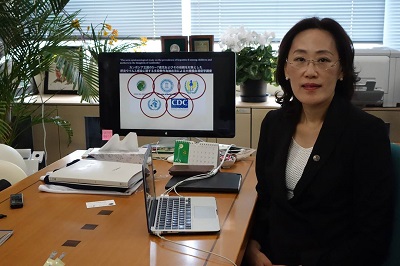
Professor Junko Tanaka wants to use her experience to assist developing nations
Hep B and Hep C are two of the world’s biggest killers. Infection during childhood of Hep B often results in reoccurring infection - increasing the chance of liver cancer and mortality. Professor Tanaka explains that the single best way to tackle this is to prevent infection in children at birth. Hep C on the other hand can become persistent at any age, and although there is no vaccination for it, there is good treatment.
While incidences of blood borne Hep B and Hep C infection are almost non-existent in Japan, this has not always been the case and is the result of decades of screening and preventative measures. The accumulated expertise gained in this process can now be used to assist developing nations such as Cambodia. For while Japan and Singapore have some of the lowest rates of infection in the world, these are outliers in Asia which shares the unenviable accolade with Africa, of being the region with the highest rate.
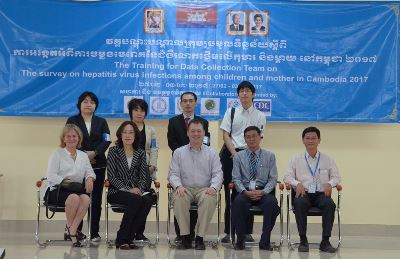
Professor Tanaka with representatives from the WHO and other parties
Most Hep B and Hep C infections occur via contact with infected blood. In developed countries, there is little chance of this occurring due to screening of blood donations and the vaccination of mothers and babies at childbirth. This is often not the case in less developed countries. The environment many people live in in developing regions also plays a role in the high prevalence there - opportunities for cuts and scratches are higher, hospitals are less likely to use disposable equipment and grooming implements such as toothbrushes and razors are more likely to be shared. Often infection occurs during childbirth. Cambodia which has a high rate – though nobody knows how high, also has several cultural factors that contribute, including the piercing of girls ears at birth, and a culture of tattooing - all increasing the risk.
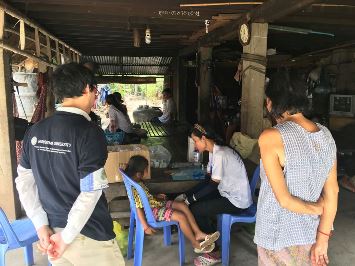
Young girl takes part in the survey
The WHO wants to reduce this rate, but until it has the necessary data it can do little to suggest improvements, or to convince the Cambodian government to invest money into preventative measures. This is where Professor Junko Tanaka can help: “In Japan we have the tools and experience. I have been chairman of the epidemic research group of epidemiological study on hepatitis virus for 20 years. I decided to give my experience to the developing countries in order to decrease infections and mortality.”
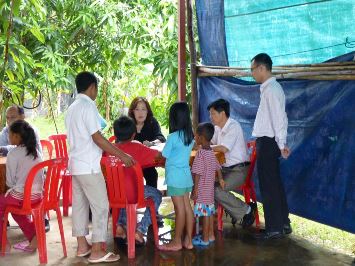
Professor Tanaka takes time to explain survey to interested children!
One of the reasons Professor Tanaka was asked to carry out this work was that she had already carried out a survey in Cambodian elementary schools in 2009 - she knew the country and the Cambodian government knew her. But this current survey is huge! It took two-years just to prepare the paper work and it will test 2,520 pairs of mother-and-child from across Cambodia - with four pairs being tested from each of the 280 randomly selected villages.
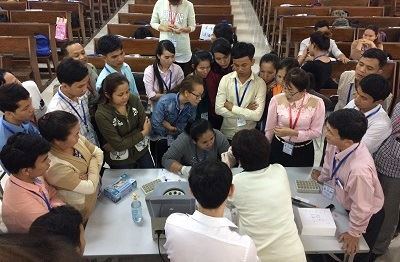
Cambodian students learn how to carry out the rapid tests
At the opening ceremony in February last year, 30 Cambodian student surveyors were hired and taught how to carry out two “rapid tests” for sourcing blood from each of the participants. The first is the “fingerprick” test where three drops of blood, sourced from the finger, are captured in a vile. The second is the “bloodspot” test where blood sourced from the participant’s finger is blotted onto paper.
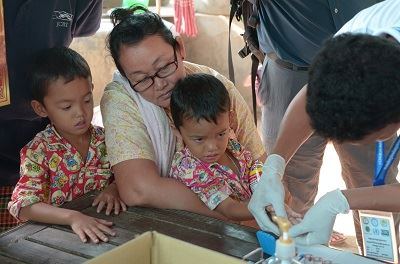
Some willing participants
If this sounds straightforward, the method for randomly selecting participants is perhaps a little more convoluted! On entering a village, the surveyors throw a pencil into the air and the direction it points to determines the street they travel along. Knocking on every door they pass in that direction they need to find not only mother-and-child participants - but ones that are willing to take part! On reaching the edge boundary of the village after their pencil determined projection, they must go back 10m and turn left before starting the door knocking once more. They continue this until they have found their four pairs.
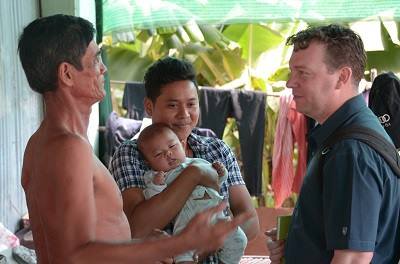
Most are happy to take part when told it is for the good of the kingdom
“This can obviously go on a long time! We knock at each house, explain what we are doing and ask them to agree to take part. Some of them refuse but most are happy to join us as we explain it is very important that you are selected. This is precious data for Cambodia.”
Professor Tanaka, for the most part, leads this survey from her base in HU’s Kasumi campus as she can’t afford to spend long periods away: “I have lots of responsibility here. When I do go, I usually stay for a month and have been over three times already. But we always have staff from here on the ground. They take part in a one-week exchange and there are three there now.”
HU faculty members are responsible for monitoring surveyors to check that they are doing the job properly. Every day they give them an appraisal which they receive via their phone. Professor Tanaka says the student surveyors are very good due to their eagerness, and the rigorous training they go through - but she concedes there are some differences in work style between Cambodia and Japan!
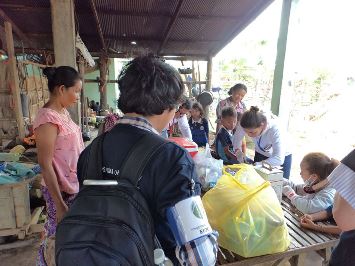
Kasumi staff assess the surveyors conduct
All of the samples will arrive at Kasumi campus this month. Professor Junko Tanaka is beginning diagnoses and the data will be passed to the World Health Organization in Switzerland in the summer. It is predicted that some hepatitis B data along with suggestions will reach the Cambodian government by the end of the year. Professor Tanaka intends to spend longer assessing the results to determine what strains are involved.
“There are many different types of Hepatitis B and C and by determining the genotype we can then know more about the infectious route – where did it come from, what lifestyle practices it stems from etc. Based on this data we can suggest screening systems perhaps or find infectious people and give them advice for treatment. We know from Japan’s experience that immunizing children is the best way but developing countries are often reluctant to spend the money. But we have lots of other proposals regarding health practices etc. At the end of the day it is up to the Cambodian government to act on the data.”
Let’s hope this example of Hiroshima University-Cambodian cooperation leads to reduced rates of infection in the country and that we can reach the goal of eliminating infection rates globally by 2030.
By Richard J. O'Connor
Originally Published on March 29, 2017
- Profile of Professor Junko Tanaka
- Project Research Center for Epidemiology and Prevention of viral hepatitis and hepatocellular carcinoma (Japanese Page)
- Find more Hiroshima University news on our Facebook page
Norifumi Miyokawa
Research Planning Office, Hiroshima University

 Home
Home